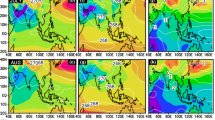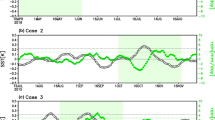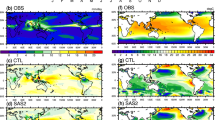Abstract
Reasonably realistic climatology of atmospheric and oceanic parameters over the Asian monsoon region is a pre-requisite for models used for monsoon studies. The biases in representing these features lead to problems in representing the strength and variability of Indian summer monsoon (ISM). This study attempts to unravel the ability of a state-of-the-art coupled model, SINTEX-F2, in simulating these characteristics of ISM. The coupled model reproduces the precipitation and circulation climatology reasonably well. However, the mean ISM is weaker than observed, as evident from various monsoon indices. A wavenumber–frequency spectrum analysis reveals that the model intraseasonal oscillations are also weaker-than-observed. One possible reason for the weaker-than-observed ISM arises from the warm bias, over the tropical oceans, especially over the equatorial western Indian Ocean, inherent in the model. This warm bias is not only confined to the surface layers, but also extends through most of the troposphere. As a result of this warm bias, the coupled model has too weak meridional tropospheric temperature gradient to drive a realistic monsoon circulation. This in turn leads to a weakening of the moisture gradient as well as the vertical shear of easterlies required for sustained northward propagation of rain band, resulting in weak monsoon circulation. It is also noted that the recently documented interaction between the interannual and intraseasonal variabilities of ISM through very long breaks (VLBs) is poor in the model. This seems to be related to the inability of the model in simulating the eastward propagating Madden–Julian oscillation during VLBs.














Similar content being viewed by others
References
Adler RF, Huffman GJ, Chang A, Ferraro R, Xie P, Janowiak J, Rudolf B, Schneider U, Curtis S, Bolvin D, Gruber A, Susskind J, Arkin P, Nelkin E (2003) The version 2 global precipitation climatology project (GPCP) monthly precipitation analysis (1979-present). J Hydrometeorol 4:1147–1167
AjayaMohan RS, Rao SA, Luo J–J, Yamagata T (2009) Influence of Indian Ocean dipole on boreal summer intraseasonal oscillations in a coupled general circulation model. J Geophys Res 114:D06119. doi:10.1029/2008JD011096
Annamalai H, Slingo J (2001) Active/break cycles: diagnosis of the intraseasonal variability over the Asian summer monsoon. Clim Dyn 18:85–102
Annamalai H, Sperber KR (2005) Regional heat sources and the active and break phases of boreal summer intraseasonal (30–50 day) variability. J Atmos Sci 62:2726–2748
Annamalai H, Slingo JM, Sperber KR, Hodges K (1999) The mean evolution and variability of the Asian summer monsoon: comparison of ECMWF and NCEP–NCAR reanalyses. Mon Weather Rev 127:1157–1186
Annamalai H, Hamilton K, Sperber KR (2007) The South Asian summer monsoon and its relationship with ENSO in the IPCC AR4 simulations. J Clim 20:1071–1092
Blanford HF (1884) On the connection of the Himalaya snowfall with dry winds and seasons of drought in India. Proc R Soc Lond 37:3–22
Bollasina M, Nigam S (2009) Indian Ocean SST, evaporation, and precipitation during the South Asian summer monsoon in IPCCAR4 coupled simulations. Clim Dyn 33:1017–1032. doi:10.1007/s00382-008-0477-4
Cherchi A, Gualdi S, Behera SK, Luo J–J, Masson S, Yamagata T, Navarra A (2007) The influence of Tropical Indian Ocean SST on the Indian summer monsoon. J Clim 20:3083–3105. doi:10.1175/JCLI4161.1
Duchon CE (1979) Lanczos filtering in one and two dimensions. J Appl Meteorol 18:1016–1022
Fischer AS, Terray P, Guilyardi E, Gualdi S, Delecluse P (2005) Two independent triggers for the Indian Ocean Dipole/zonal mode in a coupled GCM. J Clim 18:3428–3449
Gadgil S, Sajani S (1998) Monsoon precipitation in the AMIP runs. Clim Dyn 14:659–689
Goswami P, Srividya (1996) A novel neural network design for long-range prediction of rainfall pattern. Curr Sci 70:447–457
Goswami BN, Annamalai H, Krishnamurthy V (1999) A broad scale circulation index for interannual variability of the Indian summer monsoon. Q J R Meteorol Soc 125:611–633
Gowarikar V, Thapliyal V, Sarker RP, Mandal GS, Sikka DR (1989) Parametric and power regression models: new approach to long range forecasting of monsoon rain in India. Mausam 40:125–130
Gowarikar V, Thapliyal V, Kulshrestha SM, Mandal GS, Sen Roy N, Sikka DR (1991) A power regression model for long-range forecast of southwest monsoon rainfall over India. Mausam 42:125–130
Gualdi S, Guilyardi E, Navarra E, Masina E, Delecluse P (2003) The interannual variability in the tropical Indian Ocean as simulated by a coupled GCM. Clim Dyn 20:567–582
Guilyardi E, Delecluse P, Gualdi S, Navarra A (2003) Mechanisms for ENSO phase change in a coupled GCM. J Climate 16:1141–1158
Huffman GJ, Adler RF, Morrissey M, Bolvin DT, Curtis S, Joyce R, McGavock B, Susskind J (2001) Global precipitation at one-degree daily resolution from multi-satellite observations. J Hydrometeorol 2:36–50
Jiang X, Li T, Wang B (2004) Structures and mechanisms of the northward propagating boreal summer intraseasonal oscillation. J Clim 17:1022–1039
Joseph S, Sahai AK, Goswami BN (2009) Eastward propagating MJO during boreal summer and Indian monsoon droughts. Clim Dyn 32:1139–1153. doi:10.1007/s00382-008-0412-8
Joseph S, Sahai AK, Goswami BN (2010) Boreal summer intraseasonal oscillations and seasonal Indian monsoon prediction in DEMETER coupled models. Clim Dyn 35:651–667. doi:10.1007/s00382-009-0635-3
Kalnay E et al (1996) The NCEP/NCAR 40-year reanalysis project. Bull Am Meteorol Soc 77:437–471
Kang I-S, Shukla J (2006) Dynamic seasonal prediction and predictability of monsoon. In: Wang B (ed) The Asian monsoon, chap 15. Springer/Praxis Publishing Co, New York, pp 585–612
Kang I-S et al (2002) Intercomparison of atmospheric GCM simulated anomalies associated with the 1997–98 El Nino. J Clim 15:2791–2805
Kang I-S, Lee J-Y, Park C-K (2004) Potential predictability of summer mean precipitation in a dynamical seasonal prediction system with systematic error correction. J Clim 17:834–844
Kim H-M, Kang I-S, Wang B, Lee J-Y (2008) Interannual variations of the boreal summer intraseasonal variability predicted by ten atmosphere-ocean coupled models. Clim Dyn 30:485–496
Kripalani RH, Oh JH, Kulkarni A, Sabade SS, Chaudhari HS (2007) South Asian summer monsoon precipitation variability: coupled climate model simulations and projections under IPCC AR4. Theor Appl Climatol 90:133–159
Krishnamurti TN, Kishtawal C, LaRow T, Bachiochi D, Zhang Z, Williford C, Gadgil S, Surendran S (2000) Multimodel super-ensemble forecasts for weather and seasonal climate. J Clim 13:4196–4216
Krishnamurti TN, Surendran S, Shin DW, Correa-Torres RJ, Vijaya Kumar TSV, Williford E, Kummerow C, Adler RF, Simpson J, Kakar R, Olson WS, Turk FJ (2001) Real-time multianalysis-multimodel superensemble forecasts of precipitation using TRMM and SSM/I products. Mon Weather Rev 129:2861–2883
Krishnan R, Kumar V, Sugi M, Yoshimura J (2009) Internal feedbacks from monsoon–midlatitude interactions during droughts in the Indian summer monsoon. J Atmos Sci 66:553–578
Lau KM, Chan PH (1986) Aspects of the 40–50 day oscillation during the northern summer as inferred from outgoing longwave radiation. Mon Weather Rev 114:1354–1367
Lee DY, Ashok K, Ahn J-B (2011) Toward enhancement of prediction skills of multimodel ensemble seasonal prediction: a climate filter concept. J Geophys Res 116:D06116. doi:10.1029/2010JD014610
Luo J–J, Masson S, Behera S, Delecluse P, Gualdi S, Navarra A, Yamagata T (2003) South Pacific origin of the decadal ENSO-like variation as simulated by a coupled GCM. Geophys Res Let 30(24):2250. doi:10.1029/2003GL018649
Luo J–J, Masson S, Roeckner E, Madec G, Yamagata T (2005) Reducing climatology bias in an ocean–atmosphere CGCM with improved coupling physics. J Clim 18:2344–2360
Luo J–J, Masson S, Behera S, Yamagata T (2007) Experimental forecasts of Indian Ocean dipole using a coupled OAGCM. J Clim 20(10):2178–2190
Madden RA, Julian PR (1971) Detection of a 40–50 day oscillation in the zonal wind in the tropical Pacific. J Atmos Sci 28:702–708
Madden RA, Julian PR (1994) Observations of the 40–50-day tropical oscillations—a review. Mon Weather Rev 122:814–837
Madec G (2008) NEMO reference manual, ocean dynamics component: NEMO-OPA. Preliminary version. Note du Pole de modélisation, Institut Pierre-Simon Laplace (IPSL), France, No 27 ISSN No 1288-1619
Madec G, Delecluse P, Imbard M, Lévy C (1998) OPA 8.1 ocean general circulation model reference manual. Note du Pole de modélisation, Institut Pierre-Simon Laplace (IPSL), France, No11, 91 pp
Mandke SK, Sahai AK, Shinde MA, Joseph S, Chattopadhyay R (2007) Simulated changes in active/break spells during the Indian summer monsoon due to enhanced CO2 concentrations: assessment from selected coupled atmosphere–ocean global climate models. Int J Climatol 27:837–859
Masson S, Luo J–J, Madec G, Vialard J, Durand F, Gualdi S, Guilyardi E, Behera SK, Delecluse P, Navarra A, Yamagata T (2005) Impact of barrier layer on winter-spring variability of the South-Eastern Arabian Sea. Geophys Res Lett 32:L07703. doi:10.1029/2004GL021980
Masson S, Terray P, Madec G, Luo JJ, Yamagata T, Takahashi K (2011) Impact of intra-daily SST variability on ENSO characteristics in a coupled model. Clim Dyn. doi:10.1007/s00382-011-1247-2
Nordeng TE (1994) Extended versions of the convective parameterization scheme at ECMWF and their impact on the mean and transient activity of the model in the tropics. Tech. Memo. 206 Eur. Cent. for medium-range weather forecasts, Reading, UK
Parthasarathy B, Kumar RR, Kothawale DR (1992) Indian summer monsoon rainfall indices: 1871–1990. Meteorol Mag 121:174–186
Rajeevan M, Bhate J, Kale JD, Lal B (2006) High resolution daily gridded rainfall data for the Indian region: analysis of break and active monsoon spells. Curr Sci 91:296–306
Rajeevan M, Pai DS, Anil Kumar R, Lal B (2007) New statistical models for long-range forecasting of southwest monsoon rainfall over India. Clim Dyn 28:813–828
Roeckner E, Bäuml G, Bonaventura L, Brokopf R, Esch M, Giorgetta M, Hagemann S, Kirchner I, Kornblueh L, Manzini E, Rhodin A, Schlese U, Schulzweida U, Tompkins A (2003) The atmospheric general circulation model ECHAM 5. PART I: Model description. MPI-report 349
Sahai AK, Grimm AM, Satyan V, Pant GB (2003) Long-lead Prediction of Indian summer monsoon rainfall from Global SST evolution. Clim Dyn 20:855–863
Sahai AK, Chattopadhyay R, Goswami BN (2008) A SST based large multi-model ensemble forecasting system for Indian summer monsoon rainfall. Geophys Res Lett. doi:10.1029/2008GL035461
Shukla J, Mooley DA (1987) Empirical prediction of the summer monsoon rainfall over India. Mon Weather Rev 115:695–704
Smith TM, Reynolds RW (2004) Improved extended reconstruction of SST (1854–1997). J Clim 17:2466–2477
Sperber KR, Palmer TN (1996) Interannual tropical rainfall variability in general circulation model simulations associated with the atmospheric model intercomparison project. J Clim 9:2727–2750
Terray P, Guilyardi E, Fischer AS, Delecluse P (2005) Dynamics of the Indian monsoon and ENSO relationships in the SINTEX global coupled model. Clim Dyn 24:145–168. doi:10.1007/s00382-004-0479-9
Terray P, Kamala K, Masson S, Madec G, Sahai AK, Luo JJ (2011) The role of the intra-daily SST variability in the Indian monsoon variability and monsoon-ENSO–IOD relationships in a global coupled model. Clim Dyn. doi:10.1007/s00382-011-1240-9 (online)
Tiedtke M (1989) A comprehensive mass flux scheme for cumulus parameterization in large-scale models. Mon Weather Rev 117:1779–1800
Timmermann R, Goosse H, Madec G, Fichefet T, Ethe C, Duliere V (2005) On the representation of high latitude processes in the ORCA-LIM global coupled sea-ice–ocean model. Ocean Modell 8:175–201
Tozuka T, Luo J–J, Masson S, Yamagata T (2007) Seasonally stratified analysis of simulated ENSO thermodynamics. J Clim 20:4615–4627. doi:10.1175/JCLI4275.1
Valcke S (2006) OASIS3 user guide (prism_2-5). PRISM support initiative report No 3, 64 pp
Wang B, Fan Z (1999) Choice of South Asian summer monsoon indices. Bull Am Meteorol Soc 80:629–638
Wang B, Ding Q, Fu X, Kang I-S, Jin K, Shukla J, Doblas-Reyes F (2005) Fundamental challenge in simulation and prediction of summer monsoon rainfall. Geophys Res Lett 32:L15711. doi:10.1029/2005GL022734
Webster PJ, Yang S (1992) Monsoon and ENSO: selectively interactive systems. Q J R Meteorol Soc 118:877–926
Wheeler M, Kiladis GN (1999) Convectively coupled equatorial waves: analysis of clouds and temperature in the wavenumber-frequency domain. J Atmos Sci 56:374–399
Xavier PK, Goswami BN (2007) A promising alternative to prediction of seasonal mean all India rainfall. Curr Sci 93:195–202
Xavier PK, Marzin C, Goswami BN (2007) An objective definition of the Indian summer monsoon season and a new perspective on the ENSO–monsoon relationship. Q J R Meteorol Soc 133:749–764
Xavier PK, Duvel JP, Doblas-Reyes FJ (2008) Boreal summer intraseasonal variability in coupled seasonal hindcasts. J Clim 21:4477–4497
Acknowledgments
This work has been done under the Indo-French project No. 3907/1 entitled “Multi-scale interactions and predictability of the Indian summer monsoon”. IITM is funded by the Ministry of Earth Sciences, Government of India. All experiments were carried out on the Earth Simulator (JAMSTEC) in the frame of the France-Japan collaboration. Special thanks to Dr. K Ashok for help in improving the manuscript.
Author information
Authors and Affiliations
Corresponding author
Rights and permissions
About this article
Cite this article
Joseph, S., Sahai, A.K., Goswami, B.N. et al. Possible role of warm SST bias in the simulation of boreal summer monsoon in SINTEX-F2 coupled model. Clim Dyn 38, 1561–1576 (2012). https://doi.org/10.1007/s00382-011-1264-1
Received:
Accepted:
Published:
Issue Date:
DOI: https://doi.org/10.1007/s00382-011-1264-1




